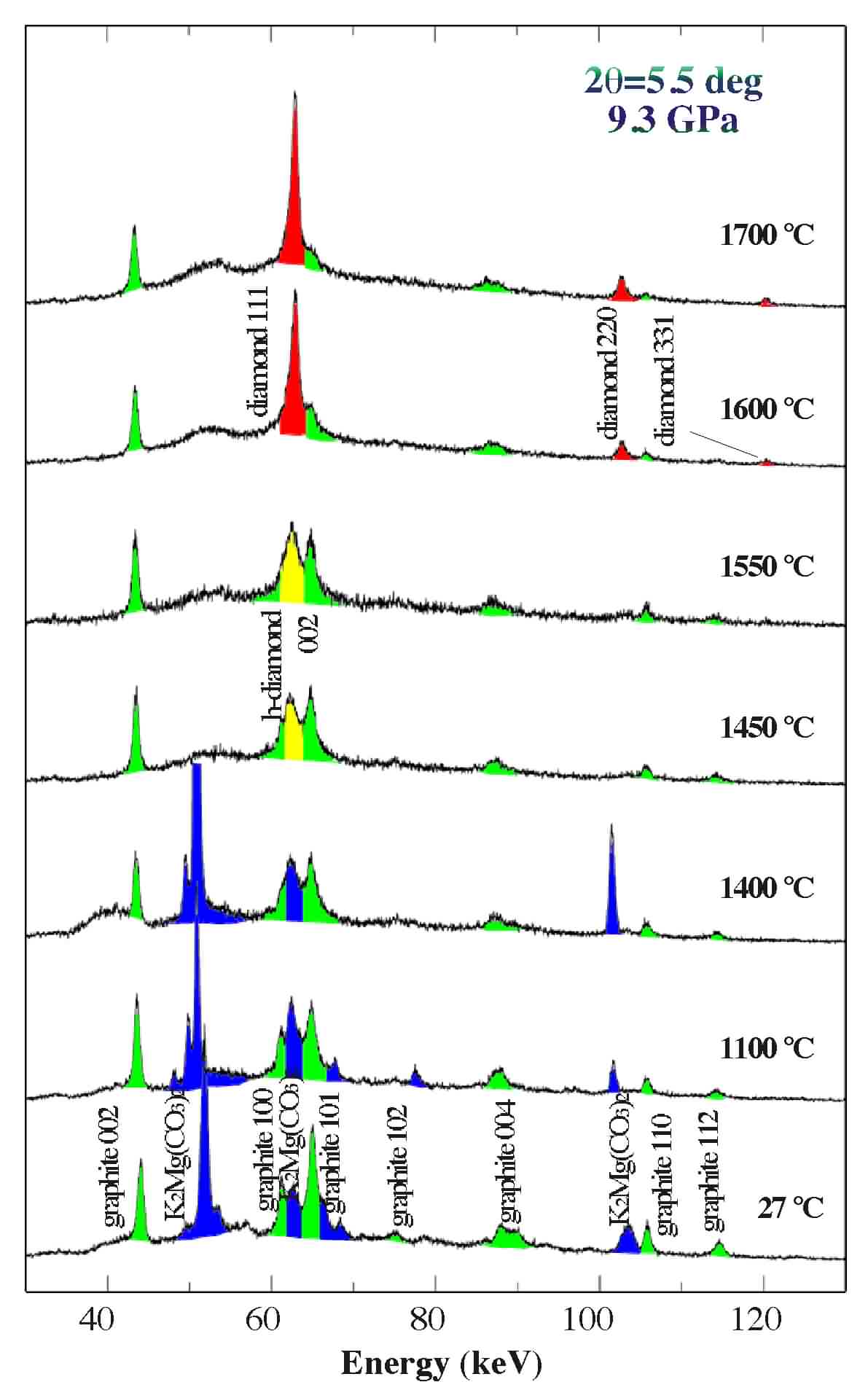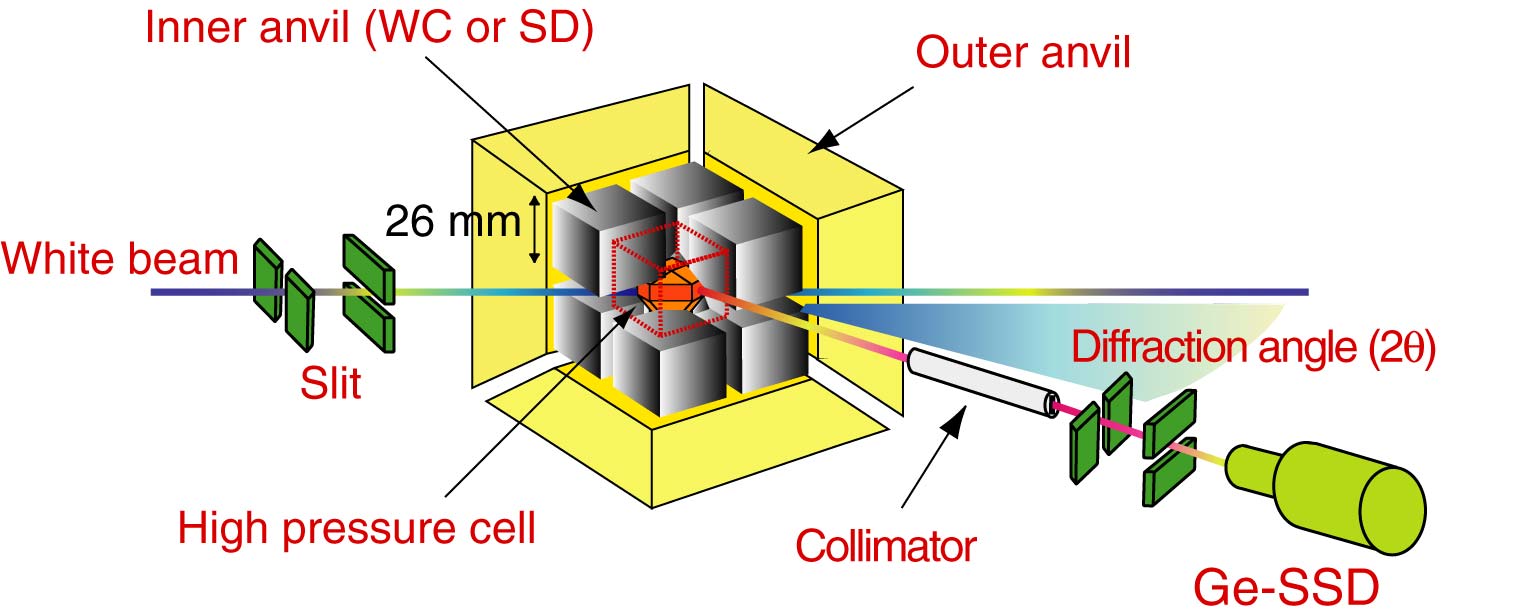Synthesis of new material at high pressure
問い合わせ番号
SOL-0000001138
ビームライン
BL04B1(高温高圧)
学術利用キーワード
| A. 試料 | 無機材料 |
|---|---|
| B. 試料詳細 | 結晶 |
| C. 手法 | X線回折 |
| D. 手法の詳細 | 粉末結晶構造解析 |
| E. 付加的測定条件 | 高圧(大型プレス), 応力付加、変形, 高温(>>500度) |
| F. エネルギー領域 | X線(>40 keV) |
| G. 目的・欲しい情報 | 結晶構造, 構造変化, 相転移 |
産業利用キーワード
| 階層1 | 環境, 化学製品, 工業材料, その他 |
|---|---|
| 階層2 | 触媒 |
| 階層3 | |
| 階層4 | 格子定数, 結晶構造 |
| 階層5 | 回折 |
分類
A80.20 金属・構造材料, A80.30 無機材料, A80.34 触媒化学, M10.20 粉末結晶回折
利用事例本文
Many studies have been investigated diamond synthesis under high pressures and high temperatures, resulting in large-scale synthesis of diamonds. However, many questions, such as the role of the catalyst, kinetics of the reaction and the possibility of a metastable phase, are still unanswered regarding the graphite-diamond transformation process under high pressures. Energy-dispersive X-ray diffraction using a large-volume press, SPEED-1500 is a powerful tool for the direct observation of the catalytic graphite-diamond conversion process at high pressure and high temperature. Figure shows a series of X-ray diffraction profiles of graphite-carbonate catalyst, K2Mg(CO3)2 system with increasing temperature at 9.3 GPa. When temperature was increased to 1450℃, a metastable hexagonal diamond peak was observed from the graphite peaks, and cubic diamond peaks began to appear over 1600℃. This result show that diamond formation using the carbonate catalyst is a different process from the behavior of the metal catalysts such as nickel or cobalt.
Fig. Variation of the X-ray diffraction profiles of graphite-K2Mg(CO3)2 system with increasing temperature at 9.3 GPa.
画像ファイルの出典
所内報
誌名
Research Frontiers (1998-1999)
ページ
23
測定手法
An energy-dispersive X-ray diffraction system attached to the Kawai-type large-volume press is shown in figure. A white X-ray beam from the bending magnet light source is collimated with vertical and horizontal slits to form a thin beam possessing a cross section of typically 0.05 x 0.1 mm2. In order to carry out the energy-dispersive X-ray diffraction on the Kawai-type system, the first-stage anvils are cut holes to pass the X-ray beam. The incident white X-ray beam from the first-stage passes through the gaps between the second-stage anvils in a horizontal plane. X-rays diffracted by samples under high-pressure and high-temperature is detected by a pure Ge solid state detector (Ge-SSD) with a 4096 multi-channel analyzer. Diffraction data can be obtained with an energy range from 20 to 150 keV. Use of a collimator (0.05 mm width) and a receiving slit at a fixed angle to the direct beam permits only the diffracted X-rays from the sample to be detected. The horizontal goniometer covers a range of 2θ angles from -10 to 23° with an accuracy of 0.0001°. The X-ray acquisition time to obtain a diffraction profile is typically one to several minutes.
Fig. Schematic drawing of the energy-dispersive X-ray diffraction on the Kawai-type large-volume press.
画像ファイルの出典
BL評価レポート
ページ
14
測定準備に必要なおおよその時間
1 日
測定装置
| 装置名 | 目的 | 性能 |
|---|---|---|
| SPEED-1500 | High pressure and high temperature experiment | 2500K, 30 GPa |
参考文献
| 文献名 |
|---|
| J. Phys. Condens. Matter, 16, S1017(2004) |
関連する手法
アンケート
SPring-8だからできた測定。他の施設では不可能もしくは難しい
本ビームラインの主力装置を使っている
測定の難易度
熟練が必要
データ解析の難易度
中程度
図に示した全てのデータを取るのにかかったシフト数
2~3シフト


